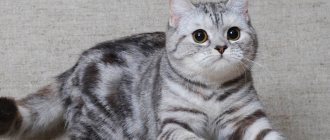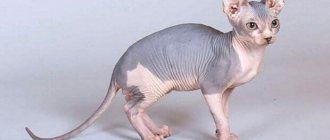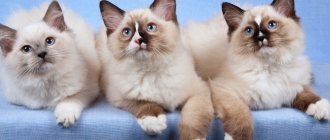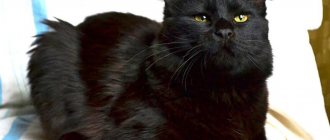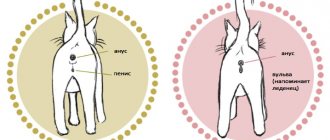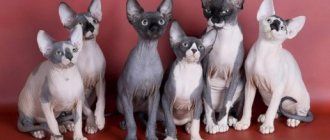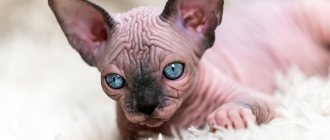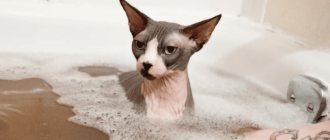Sphynx cats are unusual, graceful, intelligent animals. The article will tell you about the peculiarities of keeping Canadian and Don sphinxes, their character and behavior.
Having once met the Sphynx, many cat lovers decide to have a small representative of this hairless breed in their home. These cats are capable of charming with just one glance, and with their grace and alien appearance they can forever make a person fall in love with them.
Sphinxes are graceful, flexible animals
In order to avoid making a mistake when choosing a pet, it is necessary to take into account the differences in Sphynx breeds, as well as take into account the peculiarities of the maintenance and behavior of these cats.
Definitions
The Don Sphynx is a relatively young Russian breed of hairless cats. Animals have an unusual appearance. Their muscular body is covered with soft silky skin, and large almond-shaped eyes stand out on their expressively defined muzzle. The miniature head is complemented by large protruding ears. The uniqueness of the breed lies in the fact that not all of its representatives are completely hairless. Kittens of some species have pronounced hair, which they often lose with age. The first bald baby, acting as the founder of the breed, was born in Rostov-on-Don in 1990. The breeder's long-term breeding work has borne fruit. In 1996, the breed was officially registered, which over time gained fame throughout the world.
Don Sphynx
Velor Don Sphynx
Don Sphynx brush
Don Sphynxes have a cheerful and playful disposition. These are very friendly animals that easily get along with children and various representatives of the fauna, be it a dog or a rabbit. Cats of this breed are not characterized by rancor and vindictiveness. They dote on their owner, sometimes showing excessive intrusiveness. At the same time, Don Sphynxes remain quite independent and rebellious pets, putting themselves on the same level as humans.
The Canadian Sphynx is a breed of hairless cat that originated in 1966 in North America. It happened completely by accident. An ordinary smooth-haired pet from the Canadian town of Ontario brought kittens to her owners, one of which turned out to be completely bald. The cause of hair loss remains unclear. The main version is single natural mutations, which subsequently began to be preserved and maintained through crossing with smooth-haired cats.
Canadian Sphynx
The body of the Canadian Sphynx is strong and muscular, the head is of medium size with a clearly defined muzzle and protruding ears, the eyes are large and oval. If you run your hand over the soft, smooth skin of a cat, you can feel the presence of a small fluff, almost invisible to the eye. The animal has a long hairless tail, sometimes ending in a neat “tassel”, like a lion’s. Rolled into a donut, it is almost always pressed to the body. By nature, Canadian Sphynxes are very peaceful and loyal animals. They easily get along with other pets and are also distinguished by their healing abilities. This proud cat will never ask for handouts from the owner; it is much easier for her to quietly steal a tidbit from the table.
Appearance
Strong and muscular, but graceful body. The croup is generally wider than the shoulders and the chest is broad. Maybe a "tummy". The tail is of medium length, straight, flexible. The limbs are long, thin, the phalanges of the front paws are very mobile, which makes it possible to carry small objects and sometimes grab pieces of food or toys with their paws.
The head is wedge-shaped, the eyebrows and cheekbones are well developed. The forehead is flat, with vertical wrinkles. The ears are large and set high. The outer edge of the ear does not extend beyond the line of the cheeks. The nose is straight. The vibrissae are convoluted and thick, if present. They may not be there, or they may look broken. The eyes are almond-shaped.
The skin is elastic and forms folds, especially in the groin area, armpits, etc. In winter, young animals may become covered with short, but already noticeable fur; this feature subsequently disappears. Any color. Body temperature is around 39-40 degrees, but the animals seem even hotter to the touch.
To spite the stereotypes "woolen"
There are four types of Don Chaks, which differ in the presence and length of hair:
- Naked . They have absolutely no fur. They are called rubber or plasticine because of the sensations that are created when touching the skin.
- Flock . They feel like a peach skin and have a velvety, very short coat. Typically, by the age of two years, such animals are completely bald.
- Velor . The velor coat is noticeable, its length is 2-3 mm. It also disappears with age.
- Brush . The hair is hard and feels like a rough brush. They do not participate in exhibitions.
Important: Despite popular belief, the hypoallergenicity of hairless cats has not been medically confirmed - allergic reactions are caused not only by hair. It would be more accurate to call animals relatively hypoallergenic.
Color:
- White. Hairless, flesh-colored or cream-colored, slightly pubescent - white. Possible different colored eyes.
- Black. They can be painted from light gray to pitch black. The pads, edging of the ears, lining of the lips and eyes are black. Any eye color.
- Chocolate. Rare, not included in the standard.
- Blue. Soft blue or light gray. Blue pads, ear lining, nose.
- Red or cream. They differ in warm and cold shades.
- Tortoiseshell. Characteristic only for cats. Black with red, blue with cream, chocolate or lilac.
- Thorby. Tortoiseshell color and tabby pattern.
- Particolor. Tortoiseshell color combined with white, variegated.
- Color point. Blurred gray fading into dark areas. The eyes are dim.
Comparison
Let's start with the origin of the breeds. The Don Sphynx was bred in Russia and officially registered in 1996. This breed is relatively young and is just on the path of its formation. While the Canadian sphinxes have a half-century history. Their homeland is North America. The gene for hairlessness in Don Chaks is dominant. When crossing with smooth breeds, hairless offspring are possible. In Canadians, the hairless gene is not dominant (it is recessive).
Now let's talk about the external features of cats. The main difference between the Don Sphynx and the Canadian one is that the body of the latter is never completely bald. It is covered with a light fluff that is almost invisible to the eye. Whereas the Don Sphynxes are divided into three types. The body of naked cats is completely devoid of hair. Velor representatives of the breed have hair up to 3 mm long. But the Don Sphynxes of the brush type are covered with coarse, curly hair.
Particular attention should be paid to the animals' heads. The skull of the Don Sphynx is wedge-shaped, the cheekbones are clearly visible on the muzzle, and the forehead is noticeably sloping. Vibrissae—hard, curled whiskers—may be present. The Sphynx's skull is slightly rounded, the cheekbones are not so clearly defined, and the transition from the forehead to the nose is clearly visible. The mustache is completely absent. The eyes of the Don Sphynx are almond-shaped, slanted, and medium in size. Canadians have them large and round.
As for the physique, the representatives of the domestic breed have a denser one. The cats' chest is well developed, the muscles are pronounced, and the paws are of medium length. The animal does not jump very far. Its tail is straight, strong and flexible. Canadian Sphynxes look much more graceful. They have thin bones and long legs, making cats excellent jumpers. The animal's tail tapers towards the end and may have a small "tassel". Canadians also have an abundance of folds on the neck and armpits, which cannot be said about the Donetsk people.
It is impossible not to mention the character of the pets. Don Sphynxes are considered more affectionate, docile and curious animals. They are distinguished by good health and good endurance. Whereas Canadians are characterized by some isolation and harshness. Their pain threshold is an order of magnitude lower, and their health sometimes leaves much to be desired.
Let's summarize what is the difference between the Don and Canadian Sphynxes.
Source
Reviews about breeds
It is easier to name the breeds with which Canadians were NOT MATTED, than those with which they were MATTED. No wonder they are one of the most colorful breeds. Why does mating with a Donchak cause so many emotions? It would be strange if no one tried. The gene responsible for baldness in Don Sphynx cats should be considered conditionally dominant with the participation of modifier genes responsible for the presence of curly hair in Don Chaks. That is, kittens that are not dominant in the hairless gene can have different degrees of hairiness.
Abrakadabra
https://sphynxportal.com/forum/lofiversion/index.php/t887.html
Some lovers bought a very good cat from me about 5 years ago. 2 years later, a letter comes from them with complaints about why their cat gives birth to ordinary kittens. I’m surprised, I find out the situation (I think maybe they got brats there). It turns out that they bred a cat with a Canadian (some smart guy advised them...the cats are both naked) and the result is ordinary domus.
musena
https://sphynxportal.com/forum/lofiversion/index.php/t12778.html
I saw a photo of a kitten, which was called “wool”. The announcement said that everyone was born naked and only one was “with fur.” Outwardly, he looked like a heavily brushed Donchak. The kittens were sold as Canadians. Mom is Canadian, dad is Canadian and also the champion of Kyiv in 2010. The previous litter also contained nakeds and woollies. With difficulty, the author of the topic asked for a photo of a “purebred” Canadian. There was a phenotypically Don Sphynx.
Katya-lucky
https://sphynxportal.com/forum/lofiversion/index.php/t12778.html
Canadians are more demanding, they have a guttural voice and your neighbors will be shocked too. The Donetsk players are more practical; they can play with themselves.
Guest
https://www.woman.ru/home/animal/thread/4118773/
About the Don Sphinx
These cats, due to the fact that they do not have fur, are cold and need to move, lose energy and are therefore constantly hungry. No matter how much you give to ours, it won’t be enough.
Lesya_Kravchenko
https://irecommend.ru/content/vse-govoryat-urodlivyi-dlya-nas-zhe-krasavets-no-eshche-tot-shkodnik-esli-vy-tolko-dumaete-z
I thought it would be less of a hassle with velor than with elastic. Less, but still enough worries. You still need to bathe, because he sweats, licks himself, and it smells strongly...
Lucinda0309
https://irecommend.ru/content/khotite-myt-koshachyu-popu-zavedite-donskogo-sfinksa
Sphynxes are terribly mischievous, they do not like to be petted, but they love a light pat on the skin. Like other cats, they love to catch flies and other flying creatures. But they have one peculiarity - before starting to hunt a fly, the sphinx “hypnotizes” it with certain sounds similar to “ME-A-A” (and not ME-A-A) (not ME-A-A, but by the letters!!!), and only then the real hunt begins!
vladimir
https://forum.bolen-kot.net.ru/index.php?showtopic=498
The history of the origin of the Canadian and Don Sphynx
The first Canadian Sphynx was born about 50 years ago in Canada. The kitten's name was Prune, and he differed from his brothers in the absence of fur. Prune's owners decided to breed a new breed, but mated him with females from the same litter. The offspring were born non-viable and died.
Canadian Sphynx kitten
The second hairless kitten also appeared by chance, but this time in the American city of Waden. He was named Epidermis, and felinologists were more careful in breeding, not allowing him to mate with close relatives. This is how the Canadian Sphynx breed was developed.
The history of the appearance of the Don Sphinx is more fascinating. In 1986, in Rostov-on-Don, Elena Kovaleva saw how boys were torturing a small kitten. She saved the baby and sheltered him, giving him the name Varvara. After some time, the cat began to lose hair on her back; treatment did not produce results.
Difference in Exterior
Are there any differences in the appearance of the Don and Canadian Sphynx? Despite the fact that these breeds are similar, experienced felinologists accurately determine which type of cat a particular animal belongs to. Lack of fur is not the only sign by which breed is determined; other differences in appearance are also important.
Comparative characteristics of the Canadian and Don sphinxes:
| Exterior | Canadian Sphynx | Don Sphynx |
| Torso | The body is large with well-developed muscles. The chest is wide and round. | Medium or large. Strong muscles and skeleton. |
| Tail | Thin, sharp at the tip, where there is often a brush. | Medium length, mobile, straight. |
| Head | Short and wide head with a pronounced transition from nose to forehead. Vibrissae are completely absent. The neck is of medium length. | The head is wedge-shaped with prominent brow ridges and cheekbones. There are many skin folds and wrinkles on the head. Vibrissae may be absent; if present, they curl. The neck is long and graceful. |
| Eyes | Large and wide open, set close together. Amber color. | Almond-shaped, medium in size, slightly slanted, do not open widely. Can be any color. |
| Ears | Large, wide at the base, set straight. | Wide at the base and set straight. Slightly tilted forward. The ends are rounded. |
| Leather | Thick with numerous folds. They come in white or piebald. | Not all of the body is covered with folds: on the head, in the groin, in the armpits, on the stomach. The color can be any. |
Features of the coat
There is an opinion that sphinxes are completely hairless cats, without a single hair. This is not true: they can also be completely covered with fluff or only in certain areas of the body. The photo below shows sphinxes with different coats.
Sphynx kitten
The presence or absence of hair is one of the characteristics by which the Canadian Sphynx differs from the Don Sphynx. Canadian Sphynxes are never born naked; moreover, completely hairless individuals are not found among them - any Canadian is slightly hairy. In some areas of the body, hairs can reach a considerable length: on the face, ears, limbs, tail.
Based on the type of coat, Donchak dogs are divided into the following types:
Do sphinxes differ in character?
Differences also appear in character. Canadians are more independent and self-reliant. They do not consider a person to be their master, but behave on an equal basis with other family members. They do not need increased attention and get along well without playing with people. Donchak dogs, on the contrary, are very attached to their owners. They are obedient, friendly, and show more submissiveness than independence.
When a stranger comes into the house, Canadians hide away. When you try to pet them, they may hiss and try to bite or scratch. Donchak people, on the contrary, will treat the guest with curiosity and even allow themselves to be petted.
You should not get another pet if there is already a Sphynx living in the house. These cats are jealous, they will not tolerate competition with another pet, so there will be constant fights between the two animals. Don Sphynxes, on the contrary, will be very friendly towards a new four-legged family member.
What these cat breeds have in common is their high intelligence. They are very smart, inquisitive, easy to train and quickly learn to use the litter box.
How can you tell one sphinx from another?
They have different head shapes, and these cats also differ in size (the Canadian is larger). Another distinctive sign that will be clear even to an inexperienced person is the presence of folds on the body. Many thick folds indicate a Canadian.
Not every representative of the breed has pronounced breed traits, especially if there were crosses with other sphinxes in his pedigree. If in doubt, it is best to consult a veterinarian or professional breeder.
Source
Where is the best place to buy a Sphynx kitten?
Those who decide to get a Sphynx should definitely contact professional breeders. By purchasing a kitten at a club or at an exhibition, you can avoid problems with the health of the animal and receive guaranteed lifelong information support and support from experts in the breed.
Club Sphynx
If you still doubt whether you should have a Sphynx at home, answer yourself one question: “Do you want to get a reliable, faithful friend who does not remember insults, will be devoted to you, and will never turn away?” If the answer is yes, feel free to cast aside all doubts and take a step towards a small bald miracle.
Differences between the Don Sphynx and the Canadian Sphynx
Gone are the days when sphinxes - hairless cats - were a real curiosity. Today, many people have such pets, and they are no longer perceived as something extraordinary. For most people who are not specialized felinologists, all sphinxes look the same; they are just cats that have a very unique appearance with no fur. However, within this breed there are different varieties that differ from each other. It is not easy for the average person to distinguish the Don Sphynx from the Canadian one. Let's look at what these breeds are and which one is preferable for someone who decides to get a hairless kitten.
Cost of kittens
For those who have decided to get a Sphynx kitten, we will give some recommendations. If a person wants to get a truly purebred animal, then one should not buy it secondhand or in unverified places. The popularity of the breed is great, and in Russia there are quite a few nurseries with a good reputation. There are also venerable breeders.
Before purchasing, you need to carefully research the market, consult with the owners of similar pets, and compare prices.
Don Sphynx
In addition, you should decide for what purpose the kitten is being purchased. Its cost will greatly depend on this. On average, the price fluctuates around 10,000-15,000 rubles. But there are also more expensive kittens, the cost of which can reach up to 50,000. The most expensive kittens are the offspring of recognized champions, ideally corresponding to the breed standard and having an excellent pedigree.
As a rule, such pets are purchased in order to participate in exhibitions and breed the breed. Cheaper kittens are not always suitable for breeding, and are unlikely to be accepted for exhibitions due to minor inconsistencies in appearance. Therefore, for those who just want to buy a pet and are not going to exhibit it or take it to competitions, a cat will cost relatively little.
Canadian Sphynx
Sphinxes are very cute creatures, although not everyone likes their uniqueness. Owners of cats of this breed believe that they are kind and devoted friends, excellent companions, affectionate and gentle pets.
Photo gallery of sphinxes (Don, Canadian, Peterbald):
1111
Description and history of the Canadian Sphynx
The history of the breed goes back more than 50 years, since 1966. However, there is evidence that such cats were already encountered in ancient times. They began to be specially bred only in the mid-20th century in Canada. Today, the Canadian Sphynx is a breed recognized by all felinological organizations.
These cats have a gene responsible for the lack of hair. It is transmitted in a recessive manner. The reason for the appearance of this gene mutation is unclear. But at one time, experts began to breed a breed of hairless cats, crossing hairless animals with short-haired ones, maintaining and preserving the trait.
The body of the Canadian Sphynx is graceful, with well-developed, proportional legs. The head is small, round in shape. No mustache. The eyes are large, round, and the color of the iris is most often yellow. The ears are large and very wide at the base. Despite the fact that Sphynxes are called bald or hairless, Canadians always have a barely noticeable fluff on their body.
Main differences between breeds
| Characteristics | Canadian Sphynx | Don Sphynx |
| Body | Elegant, quite compact, with long limbs, folds on the skin, localized mainly in the armpits and in the neck area. The animal is very graceful. | Quite squat, but proportional, with well-developed legs, a wide chest, good muscles. |
| Head | Small, prominent, with a clearly visible transition from the forehead to the nose. | Wedge-shaped, with well-defined cheekbones, wide at the top and tapering downward. |
| Ears | Large, set quite low, widely spaced. | Large, long, straight, located high. |
| Eyes | Large, round, wide open. | Almond-shaped, set slightly at an angle, small in size. |
| Mustache | None. | They may be small, as if broken off, sometimes they resemble small bent antennas. |
| Hairline | Barely noticeable fluff. | Completely absent, some individuals have a little hair on the head, paws, and tail. |
| Teeth | Good teeth, but some individuals have a predisposition to teeth diseases. | Strong, white enamel. |
| Jumpability | Due to their body structure, they jump well and far and can move to a fairly high place. | Not very jumpy. |
| Character | Soft-spoken, friendly, can be a little reserved. | A curious and active animal with a strong psyche, contented and willful. |
| Genetic characteristics/hairlessness gene | Recessive. | Dominant. |
What is the difference?
An experienced breeder or amateur will determine at first glance who exactly is in front of him. Detailed information about the difference in appearance and habits will help everyone else understand this issue. It must be considered according to several criteria.
Build
The first type has a wedge-shaped skull, sharply defined cheekbones, and a sloping forehead. The physique is dense , the chest is quite developed. Limbs of medium length, moderate ability to jump over long distances. The tail line is straight. It is strong and flexible.
The second has a rounded skull, less clarity in the lines of the muzzle, except for the bridge of the nose. The shapes are more graceful, the bones are thinner. Long legs, excellent jumping ability. The tail is narrowed; a “lion” tassel can stand out at the tip.
Sight
In both species it is magical, attracting to itself like a magnet. Only the Don Sphynxes have almond-shaped, slanted eyes, while their opponents have large, round eyes.
Hairiness degree
In the first case, naked gene carriers are completely hairless animals. Only the brush is born with hairs in the form of hard curls . Sometimes there are mustache curls. The skin is smooth.
Mr. Cat recommends: genetic characteristics that determine hair type
The most important difference between the Don and Canadian Sphynx is that the hairless gene is transmitted in a different type. In Canadians, the gene that determines the lack of hair is recessive. That is, it is capable of ensuring the manifestation of hairlessness only when paired with the same recessive allele. If a dominant allele is present, the trait is suppressed. For this reason, Sphynx cats usually have a little fluff on their bodies.
In Don Sphynxes, the gene for hairlessness is dominant, suppressing recessive alleles, so this trait is fully manifested in the offspring. Cats can be completely hairless, sometimes there is a little hair on the head, tail, and limbs.
Canadians have no mustache at all, while Donetsk people may have small whiskers. Breeds differ in body structure, head and ear shape.
Different breed genetics
Getting to know the fascinating world of chromosomes, loci and genes that are responsible for the absence of hair will help you better study the differences between the Don and Canadian Sphynxes.
Canadian Sphynx
Since this cat breed was the first to appear, observations of it contain a greater amount of knowledge. The selection was carried out purposefully and took into account the rich experience accumulated by felinologists.
- Back in 1938 Frenchman Etienne Letard published a description with a list of differences between hairless kittens. True, they were not talking about Canadian (and especially Don) sphinxes, but about Siamese. The allelic gene from this work was precisely the reason for the appearance of the Canadian Sphynx.
- The "bald" mutation occurs due to the recessive hr gene. In the animal's genetic map, it is responsible for the absence of integument.
- Canadian cats cannot be crossed with other breeds. The Devon Rex took part in its breeding, and hr still carries information about the difference in their genome.
Objectively, these cats are not completely hairless. They have residual growth on their tail, paws and head.
Don Sphynx
We can say that this breed is the result of a happy coincidence. If domestic lovers did not know about the existence of the bald Canadian Sphynx, they would hardly have decided on such a dizzying genetic adventure.
Comparison of characters
The nature of the breeds differs quite greatly. Don Sphynxes are playful and very inquisitive. These are excellent pets for families with children, as they are not prone to display aggression. If there is a very small child in the family, then his contact with the cat should be limited for the safety of the animal itself. Babies are not very good at playing with cats and can damage their delicate skin. Older children should clearly understand that they need to behave carefully with the cat so as not to harm it. When adults are convinced that the child understands how to behave, then you can leave them to play together without any problems. The Sphinx will support any fun activity.
Donchak people are very curious, love to be the center of attention and consider themselves obliged to take part in all events taking place in the house. They really need to communicate with a person, they can literally beat underfoot without leaving a single step. Sometimes they even become intrusive, but there are no more devoted and selfless friends.
They usually adore their family members. They treat strangers quite friendly and with interest. They may willingly go into their arms, but this does not apply to all Donetsk people. They get along well with other animals.
Compared to their Russian counterparts, Canadians are distinguished by their isolation, caution, and secrecy. They most often choose one person as their master, giving him their love and tenderness. They behave quite friendly with the rest of the family, but you can immediately see who the animal’s favorite is. They do not get along well with other animals.
Canadian Sphynx dogs are distinguished by their reserved manners. They never allow themselves to impose their company, beg for food, or do any other similar things. They will not allow themselves to be offended, and in relationships with people they demand equality, partnership, and mutual respect.
Differences in character: a family for a cat or vice versa
Any appearance fades into the background when it comes to the behavior and attitude of animals towards people. After all, some cats are capable of demonstrating quite predatory habits, even aggression. In families with children, such an animal has nothing to do.
Fortunately, Sphynxes belong to the group of quite friendly representatives of the cat family, although Dons and Canadians have differences here too.
The Don Sphynx is friendly towards all family members and pets. The Sphynx kitten will spin under your feet, look into your eyes and wait for any reason to play together. Representatives of this breed are not afraid of new people and react calmly to large, noisy companies.
Canadians are less sociable; they choose their owner independently and prefer to spend time only with him. The head of the family does not necessarily become such an authority.
They treat other cats and dogs calmly - they will put up with such proximity, but will try to keep their distance from the group.
When trying to reduce the communication distance that is comfortable for him, the animal may show aggression. Even the exhibition standards of these cats provide for removal from the ring if the competitor does not give in to the hands of the referee and shows emotional incontinence.
Caring for the Don and Canadian Sphynx
There are generally no differences in the maintenance and care of both breeds. Cats that have little or no hair need special care for their skin. Both Canadian and Don Sphynx cats should be bathed frequently, approximately once every two weeks. Kittens are washed in a basin; an adult animal can be washed directly in the bath. For bathing, soapy water is made at a fairly high temperature: the pet should not be cold. You need to wash your Sphynx thoroughly, using a soft washcloth to treat all areas of the body, making sure to wash the skin folds.
Care
The Donchak is not a picky animal and can even be said to be independent. But just like all cats, it requires attention, affection and care.
Skin care and bathing
Although cats are hairless, it is important to monitor the condition of their skin. It is precisely because of the lack of hair that Don Sphynx cats sweat and secrete a fatty substance that protects the skin.
Over time, if the cat is not bathed, the layer becomes noticeable and causes discomfort to both the cat and the owners. Therefore, bathe your cat, but not more than 1-2 times a week. Otherwise, the cat's skin will dry out. To avoid causing pain to the animal, wash the cat with a soft washcloth or soft sponge.
To bathe, fill the bathtub with water; you need to fill it so that the water level is no higher than the cat’s chest, otherwise water gets into the nose. Make the water not cold, but not hot either. Apply shampoo to your body and gently rub over your skin. Afterwards, rinse the shampoo with water and wrap your pet in a towel and let it dry.
Useful video on how to properly wash your Sphynx:
To prevent acne from developing on your pet's tail, you need to wipe it regularly. If this is not done, the sebaceous glands will clog the pores. For wiping, use a special lotion or degreasers that do not contain alcohol. After the procedure, rinse off the remaining substance with warm water and wipe with a towel. If acne appears frequently and in large quantities, take your cat to the veterinarian.
Monitor your cat's time in the sun. Due to the lack of fur, the Don Sphynx gets sunburned if it stays in the sun for a long time. Therefore, do not leave your cat unattended. If your cat is sunburned, do not apply sunscreen lotions or creams on it. Over time, the tan will subside, the skin will peel off and return to its normal appearance.
Eyes and ears
Due to the lack of eyelashes on the Don Sphynx, the risk of eye contamination increases. It is acceptable if the discharge from the eyes is transparent. But if the color is yellow, brown, green or white, this means the presence of infection in the body. In this case, contact your veterinarian.
Wipe your cat's eyes with a cotton swab dipped in a solution of chamomile or tea leaves. Do not use a towel or paper napkins as there is a high chance that lint or paper particles will get into your eyes.
It is recommended to clean the ears of the Don Sphynx once every 1-2 weeks, at least. Due to the large ears of the Don Sphynx, wax often accumulates in the ears, which should be removed. To do this, use a cotton swab. Do not clean too deeply, but at the same time remove the discharge completely.
The pharmacy also sells a special liquid for cleaning ears. Place liquid in the cat's ear, leave it for a while, and then wipe it dry so that the cat doesn't accidentally put it in his mouth.
Claws
When trimming nails, it is important not to touch the cat's nerve endings. They are located 2-3 millimeters from the beginning of the claw
For trimming, use a special nail clipper, sold in special stores. Secure the cat motionless and carefully trim each claw. Perform this procedure regularly as new claws grow.
Nutrition
Due to high energy metabolism and increased body temperature, metabolism increases
Therefore, pay special attention to feeding your pet. Unlike cats with fur, which are fed 2-3 times a day, the Don Sphynx is fed 3-4 times
It is recommended to create a schedule and give food on a schedule.
The cat's diet should include vital substances: proteins, fats, carbohydrates. It is recommended to give the Don Sphynx both natural food: meat, fish, milk, vegetables, and dry food. The diet and portion sizes are tailored for each pet individually.
Walking your pet
Walking the Don Sphynx is not so easy due to the lack of fur. During the cold season, it is better to keep your pet at home, as it can easily get sick. If it is not completely cold outside, then you need to walk your pet in special clothes. On hot days, do not walk for too long; although sunlight has a positive effect on the body, the cat may well get sunburned.
Sphynx diseases
Due to their unique appearance, the main problems for sphinxes arise with the skin. Due to the intense work of the sebaceous and sweat glands, representatives of this breed may experience problems. If the animal's skin is not cleaned daily and bathed regularly, then pustules begin to form and acne appears.
When such problems appear in your pet, you should take him to the veterinarian. The doctor will prescribe treatment and give recommendations for caring for problem skin.
Diseases of the Don Sphynxes are mainly associated with various negative effects and skin lesions. The animal may experience the following problems:
- colds due to hypothermia (the sphinx can get sick even from a short stay in a draft or in a cool room);
- sunburn: exposure to direct sunlight is also contraindicated for sphinxes, as is cold (there are special creams to protect against the harmful effects of the sun);
- inflammatory skin diseases (dermatitis) that occur due to exposure to allergens, deficiency of the iodine-containing hormone thyroxine;
- trichophytosis (dermatophytosis or ringworm) is an infectious disease caused by fungi;
- allergic reactions that appear on the skin;
- eczema is a nonspecific inflammatory skin disease, manifested by skin rashes, itching, and severe discomfort.
Canadian Sphynx
All these pathologies are also found in Canadians, since they are also hairless. Canadian Sphynx cats are susceptible to the following diseases, which can also occur in Donetsk cats:
- a shortened lower jaw is a congenital developmental anomaly that may not cause harm to the pet, but when excessively expressed it causes serious damage to the oral cavity due to malocclusion (all cats with such a defect are excluded from breeding);
- microphthalmos – underdevelopment of the eyeball, often accompanied by other disorders and lesions of the visual apparatus: keratitis, cataracts, tumors, orbital cysts;
- curvature of the caudal part of the spine is a hereditary pathology, very common in sphinxes, accompanied by underdevelopment of the lower intestines, short thoracic and lumbar spine (kittens with such an anomaly are usually not viable);
- immunopathological inflammation of blood vessels (vasculitis);
- nipple hyperplasia is a hereditary anomaly transmitted through the female line (sometimes accompanied by underdevelopment of internal organs, which makes kittens unviable);
- Entropion is a genetically determined congenital defect, manifested by the edges of the eyelids being turned inwards (this pathology must be eliminated surgically, otherwise the animal will develop a chronic inflammatory process of the eye mucosa);
- “Kitten falling asleep” is a genetic disease accompanied by underdevelopment of internal organs, making kittens unviable (usually observed in a litter born as a result of crossing two hairless Don Sphynx cats).
Canadian Sphynx
Mating
Males of these breeds reach sexual maturity by the age of one year; in females, the first estrus usually occurs at the age of 6-8 months. There is no need to breed sphinxes during this period. It is recommended to carry out the first mating at the age of 1.5-2 years; by this age they can already produce full-fledged offspring.
Traditionally, the female is brought to visit the groom, whose owner prepares all the conditions for the “wedding.” The most favorable moment for this is 3-5 days of estrus. Cats should be comfortable and not be distracted by anything. For the bride, you need to prepare a place where she can hide if suddenly she actively does not like the proposed groom.
Before mating, both animals must be examined by a veterinarian and their claws trimmed. A course of anthelmintic drugs must be administered within 2-3 weeks. It is strictly not recommended to bathe a cat before mating. The cat must feel the specific smell emitted by the animal during the period when the hormonal background is most consistent with procreation.

